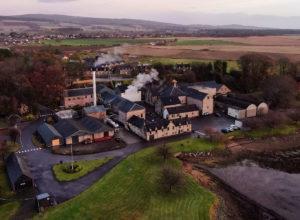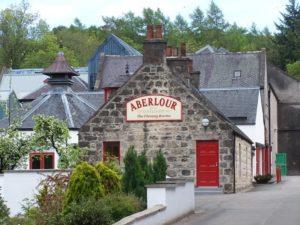** This article was previously published in the Whiskey Network newsletter as a four-part series by Greybeard**
Exploration of Scotch Whisky
It is hard to turn around in today’s society and not have heard something about Scotch. You will see it in the movies, television shows, and all over the media and internet. Scotch’s vast history dates back to the 15th century, with the earliest known distillery in Scotland operating in 1494. This article, however, will not be about the history of Scotch, but instead will be a walk through the different regions in Scotland and the Scotches made there.
Before we get into the regions of Scotland, there are five classifications or types of Scotch that we will want to understand. Also, it would be good to briefly cover the regulations of how a Scotch is to be distilled.
Scotch Classifications
Single Malt
Single Malts are one of the most common types of Scotches known. The scotch can be classified as a single malt when made at a single distillery, in a pot still, and using only water and malt.
Single Grain
Single Grain will follow the exact requirements as a single malt, except other cereal grains can be added to the mash bill.
Blended Malt (or Blended Single Malt)
Blended Malts will be a blend of two or more Single Malts from two or more distilleries.
Blended Grain (or Blended Single Grain)
Blended Grain will be a blend of two or more Single Grains from two or more distilleries.
Blended Scotch
Blended Scotch, which constitutes approximately 90% of the whisky produced in Scotland, will contain both malt and grain whisky.
Regulations
The regulations which define what a Scotch are:
- Bottled at no less than 40% ABV
- Contains no additives other than water and caramel coloring
- Distilled in Scotland from water and malted barley
- Distilled at no more than 94.8% ABV
- Fermented at that distillery by adding only yeast to create the enzymes needed for fermentation
- Aged for a minimum of three years in oak casks
Regions
There are five regions of Scotland where the 134 plus distilleries reside: The Highlands, The Lowlands, Speyside, Islay, and Campbletown.
The Highlands
The Highlands is the largest of the five regions and is home to 30 distilleries. Scotch coming from The Highlands can be described as fruity, sweet, spicy, and malty. Some of the well-known distilleries in this region are Aberfeldy, Dalmore, Glenmorangie, and Glendronach.
The Lowlands
The Lowlands cover much of the central and southern portions of Scotland. The single malts from The Lowlands are often described as sweet with floral notes. Here you will find distilleries such as Bladnoch, Glenkinchi, and Auchentoshan.
Speyside
Speyside was part of The Highlands until becoming a region of its own in 2014. It is located in northeastern Scotland, surrounding the River Spey. Well-known distilleries such as Aberlour, Balvenie, The Macallan, and The Glenlivet call Speyside home and can be described as sweet, caramel, fruity, and fragrantly floral.
Campbletown
Once home to over 30 distilleries, Campbletown has recently started rebuilding its reputation for producing quality scotches by rebuilding Glen Scotia. The whiskies from this region can be described as fruity, peaty, sweet, and smoky.
Islay
Thanks to the television show “Parks and Recreation,” Lagavulin has become one of the more recognized Scotches from this region. Islay is also home to other distilleries such as Ardbeg, Bunnahabhain, and Laphroaig. Scotches from Islay are also well known for distinctive notes such as peaty, smoky, medicinal, and robust.
As you can see, the variety of expressions for Scotch is as wide as other whiskies of the world. In the coming articles, we will look at Scotches from Islay, Speyside, and The Highland regions, along with possible cigar pairings for each region.
So, hop aboard as we journey through the world of Scotch.
The Highlands a Legacy in Scotch
Whenever we think of Scotch, we generally think of The Highlands as where most Scotch is made; this, while partially true, is likely due to movies and characters such as James Bond and the Scotches represented. Before 2014 around 70 of the 134 distilleries in Scotland were located in The Highlands. Since the Speyside region’s formation, there are now about 40 distilleries in The Highlands, with The Dalmore, Glenmorangie, and Glendronach being the most recognized of them. Scotch from The Highlands has made its name known for big robust flavors, whereas other regions such as Lowlands are known for lighter, more subtle flavors due to greater access to barley.
The variety of flavors in scotch from The Highlands is about as vast as the region itself. While most of the area will share notes such as cereal grains and fruit, the Northern part tends to the sweeter side of the cereal grains, whereas the Eastern and Southern regions tend to be drier with bolder fruity notes. The Western area of Highland is known for an even different take on their whiskies, where they lean more towards the full-bodied, pungent, smoky notes reminiscent of those found in Islay.
The Dalmore Distillery
Located on the northern shore of Cromarty Firth, an inlet of the North Sea, you will find Dalmore Distillery. Legend has it that the Dalmore distillery dates back to the 13th century. However, it was founded in the 19th century in 1839. Getting their water from the Alness River, Dalmore has a rich history of Single Malts, distilled in flat top stills and then double cask aged. The casks will always be an American White Oak Bourbon cask and then a Sherry cask from Gonzales Byass, one of Spain’s most well-known Sherry Winery.
Dalmore 15
The Dalmore 15 was my first experience with their Scotches. After having tried this expression, I was hooked. With aromas of stone fruit, vanilla, and smoke and rich oils, black cherry, and vanilla on the palate, this Scotch is one that every whisky connoisseur will want to add to their collection.
Pairing
Pairing a cigar with a Scotch can be a challenge. With such complexity in profile and the variety of notes, you will want to find a bold cigar to stand with the drink but not overpower it. For Scotch from the Highlands, I would recommend looking for a cigar that leans more towards the fruit and floral notes with bolder notes of oils and subtle spice. Cigars with Ecuadorian or Brazilian wrappers would be an excellent pairing for any Scotch from The Highlands.

Into the Spey
The River Spey, the second longest and fastest flowing river in Scotland, cuts through the region and provides water for many distilleries. It is also where the name of the region Speyside gets its name. It wasn’t until 2014 that Speyside became an official whisky-producing region in Scotland, whereas before then, it was part of The Highlands.
Speyside is home to 40-plus distilleries with the sub-region of Dufftown, home of Balvenie and Glenfiddich, producing upwards of 40 million liters of Scotch annually. Speyside is also home to well-known distilleries such as Aberlour, Macallan, Glenlivet, and Tomintoul. It is estimated that 50 percent of the whisky produced in Scotland comes from this region.
Besides the amount of whisky produced in Scotland and the number of jobs the distilleries produce for the region, Speyside has a significant tourist attraction, bringing in almost two million visitors each year, accounting for over £60m in 2017.
Aberlour 12 Single Malt Double Cask Matured
Founded in the 1800s by James Fleming, Aberlour has a long history of making Single Malts. Located along the banks of the River Spey, Aberlour releases a range of single malts of various ages, including the 12-year aged in a Sherry cask and an American Oak cask, before coming together to form the final product.
The 12-year has a lovely rich amber color which it pulls from the American Oak, also giving it rounded fruity notes with hints of vanilla on the nose. The palate for this 12-year brings forth the darker fruity notes, that of black cherries with subtle hints of cocoa and spice. The buttery texture fits perfectly with the long sweet, spicy finish leaving you wanting another dram as soon as your pour is finished.
Pairings
I recommend pairing it with a Brazilian, Honduran, or Dominican wrapper cigar for this particular Scotch. Look for one that will present more earthy notes and notes of stone fruit, such as peaches or apricots. This will balance out the sweet spice in the whisky while allowing the floral and fruity notes to become more prominent.

Islay of Smoke
One of many islands surrounding the mainland of Scotland, and while not the biggest, it is one of the region’s most well-known and probably incorrectly pronounced islands. As a matter of fact, over the years, I have heard pronunciations such as “Is-Lay” and “I-Slay,” whereas the correct pronunciation would be “Eye-Lay.”
Rich in both Gaelic and Norse history, what Islay is known for in current times is its rich history of Uisce Beatha, literally, Water of Life, which is the name for Whisky in Scotland. Home to nine distilleries such as Ardbeg, Bowmore, Bunnahabhain, Lagavulin, and Laphroaig, the whisky from this island is well known for being smokey and peaty.
Many will describe the Scotch from Islay as smokey and directly equate that with being peaty. At the same time, the process of drying the malt in its preparation for the distillation process does relate the two. They both are distinctly unique.
The process that many of the distilleries on the Isle of Islay use to dry the malt consists of burning peat where the smoke will dry the malted barley. For centuries this took place on a wooden floor where the distillers would spread the malted barely out on the floor and burn the peat underneath the bed where the smoke would rise through the cracks and dry the malted barley to prepare it for the fermentation process. The smoke would infuse with the barley giving it smokey notes, and then, depending on the amount of peat used, would determine how peaty the whisky would be. Master distillers would then use different combinations of peat and time smoked to achieve that flavor profile they were looking for. Some Islay Scotches, such as Lagavulin and Laphroaig, is very smokey, whereas their peat content is low compared to Ardbeg and Bunnahabhain. Because of the medicinal notes commonly acquainted with peaty Scotches, the Islay Scotches have some unique profiles and the most significant amount of acclimation required to enjoy fully. However, once you are acclimated to their special notes, the Scotches from Islay are some of the best.
Kilchoman
Built in 2005, Kilchoman is the first distillery to be built in over 100 years and is the only 100% Islay distillery, meaning that from farm to bottle, they are a single farm, single malt scotch. Growing their barley and peat, every part of the process of bottling a Single Malt from Kilchoman comes from Islay.
Kilchoman presents four primary expressions of their Scotch with two limited editions, each offering a unique profile and barreled in both bourbon and sherry casks for a minimum of 3 years, making it a very young Scotch.
Kilchoman 2016 Cask Strength
The Cask Strength version of Kilchoman was first introduced in 2014 and then again in 2016. Coming in at 56.9% ABV or 114 proof, it is aged for six years in ex-bourbon Casks. The color is that of golden yellow honey and presents notes of peat, honey, and apples with hints of spice, vanilla, and oak on the nose. The palate continues with the notes from the nose, adding gamey notes reminiscent of beef jerky and finishing long with peat lingering on at the back of the throat.
Pairing
Because of Kilchomans’ young age and unique profile, I recommend pairing their expressions with a medium bold cigar from the Dominican Republic to pull out the floral notes of both the Scotch and the cigar.





Comments are closed.